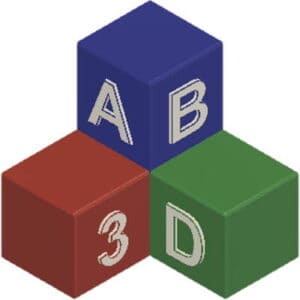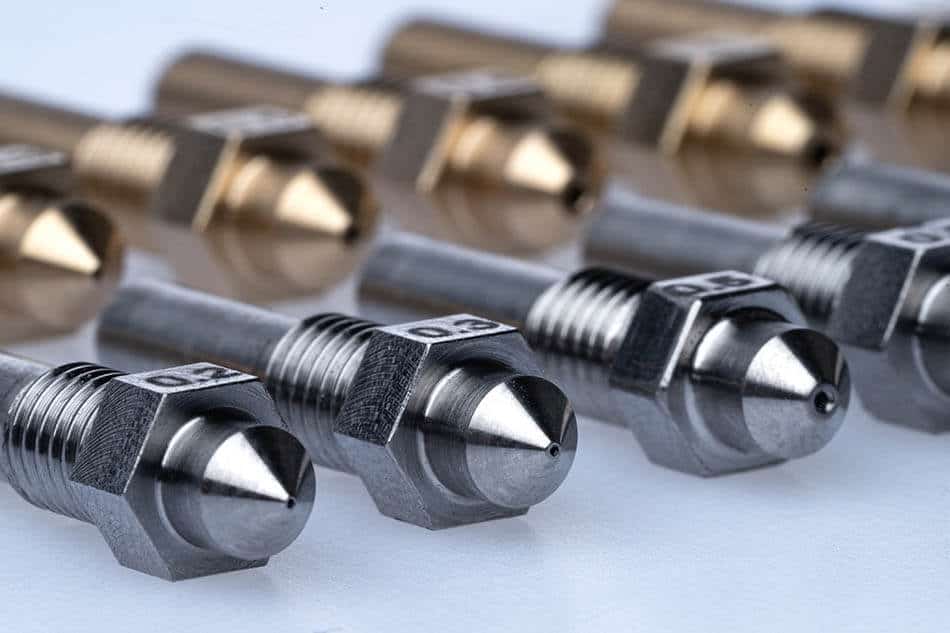This post is also available in:
![]()
In 3D printing, choosing the right nozzle is an important factor for the quality of the printout. A question that therefore arises very often is: should one use a separate set of nozzles per material type or is it sufficient to have one set of nozzles for different materials?
In general, it is not a must to use separate nozzles per material, but in many cases it makes sense. Particularly when materials with widely differing temperature ranges are often used, there is a risk that material residues in the nozzle will have a negative impact on the print result. Here, a separate set of nozzles per material pays off.
However, as is so often the case, every advantage also brings one or two disadvantages. I will discuss the advantages and disadvantages of using your own nozzle sets per material later in this blog.
Does a separate nozzle per material type make sense?
As already written at the beginning, it is not a must to use a separate set of nozzles in different diameters per material. Especially when using standard brass nozzles, however, it is definitely recommended. If you use nozzles with special coatings (for example, the E3D V6 Nozzle X Düse), it is very likely not necessary. Ultimately, however, it depends heavily on external influences such as standards, customer requirements or the intended use of the print object. Thus, this question – as so often – would have to be answered quite classically with “Jain”.
Based on my experience over the last few years in both the semi-professional and professional/industrial sectors, I can only answer this question with “Yes, it definitely makes sense”. Especially if you often work with different filaments in very different temperature ranges and you want to make professional prints. Sometimes, however, normative or qualitative requirements from a customer force you to use either completely new nozzles or nozzles that were previously used to print only a certain material.
The situation is different in the semi-professional sector. Here, it’s often simply a matter of printing things. Sometimes minor defects or imperfections in the surface can be tolerated here. Nevertheless, this issue should not be completely neglected here either. This is because, apart from the negative influence on the print result, which can be caused by material residues of the previously used filament in the nozzle, printing with one and the same nozzle for all materials can also lead to clogging of the nozzle and, in the worst case, to damage to the print head. Of course, you can also get around the problem here with special nozzles such as the Brozzl Ruby 0,4 mm (Messing mit Rubin) or the E3D V6 Nozzle X Düse already mentioned above if you are willing to dig deeper into your pocket for a single nozzle.
Why use your own nozzles?
As mentioned, small amounts of filament residue remain in the nozzle after each print, which can cause problems during the next print. Depending on whether you switch from a lower temperature range filament to a higher temperature range filament, the effects can be different.
If a change is made from a colder material to be printed to a hotter material to be printed, it is possible that these filament remnants – if they do not come out of the nozzle in the course of the filament change – burn due to the higher temperatures in the nozzle and only come out of the nozzle in the course of printing. This can lead to burn marks in the printed object.
When changing from a hotter to a colder material, the die may not reach the temperatures necessary for the filament residue to be heated enough to change to a liquid state and be extruded from the die. This can lead to restricted filament flow or, in the worst case, to a totally clogged nozzle.
Apart from the qualitative or normative requirements mentioned in the previous section, which a print job may entail, sometimes it may simply be the abrasiveness of the material used which makes the use of a separate, possibly even special nozzle necessary.
What are the disadvantages of using different nozzle sets per material?
The main disadvantages of using different nozzles for each material are partly obvious.
The acquisition costs for a set of standard brass nozzles in the common diameters, such as the E3D V6 Fun Pack, are around €38 as of February 2023. If different materials are printed, it is possible that three, four or more sets are necessary and € 100-150,- are already gone. If it then also different special nozzles, for example the Brozzl Ruby 0,4 mm (Messing mit Rubin) around approx. € 100, – per piece is needed, it becomes very fast unpleasantly expensive.
But it is not only the acquisition costs that need to be considered. There is also the added expense of ongoing nozzle changes before each print, and also the organization/management of the various nozzles.
Can materials with similar temperature ranges be printed with the same nozzle?
Yes, of course materials with similar temperature range can be printed with the same nozzle. For a long time, I myself used only one set of nozzles for all kinds of filaments. As written earlier in this post, it is generally not mandatory to use a separate nozzle for each material.
So, if you don’t want to go through the full insanity of time, space, organization and cost, then combining materials with similar properties or temperature ranges is a perfectly reasonable approach.
Is cleaning the nozzle a viable alternative to different nozzle sets?
Cleaning the nozzle is a good but by no means perfect alternative to separate nozzle sets. Basically, it is not a mistake to clean the nozzle with cleaning filament, and with a very high probability, this will be enough in most cases.
However, there is no absolute certainty that all remnants of the old filament have been removed.
In this context, besides the cleaning filament linked above, I can highly recommend you this 3DJake - Düsenreinigungsset.
How to manage multiple sets of nozzles in a meaningful way?
Regarding the management, different approaches are possible, which of course also depend somewhat on how the nozzles are procured.
If a complete set of nozzles is purchased, such as this E3D V6 Fun Pack or E3D V6 Pro Pack, it is natural to use the can in which the nozzle set is supplied for a particular type of material.
If the nozzles are purchased individually depending on the need, then this case is usually supplied in small resealable plastic bags. Of course, these can also be used for storage with appropriate labeling. Alternatively, you can print small – or even larger – containers for storing the nozzles yourself. After all, what is a 3D printer for?
On the platform thingiverse.com you can find some very creative templates for storing nozzles.
Linked products
In this article some materials and tools were mentioned, which I can recommend without bad conscience. The links are so-called affiliate links. If you click on one of the links and buy the product, I get a small compensation from the respective merchant.
If this and possibly other articles on the site have been helpful to you and you would like to support this blog, I would greatly appreciate it if you would use one of these links in this article or one of the others in the recommended products category when making your next material or parts purchase. Thank you very much.


